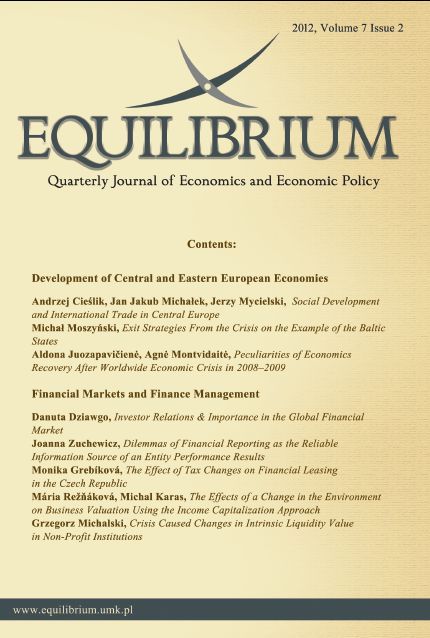Social Development and International Trade in Central Europe
DOI:
https://doi.org/10.12775/EQUIL.2012.008Keywords:
social development indices, bilateral trade flowsAbstract
In this paper we study the impact of social development on international trade in Central and Eastern Europe using the generalized gravity model. Many previous empirical studies which explored the determinants of trade flows, concentrated only on traditional gravity variables, such as the size of trading partners, factor abundance, technology differences or distance. In our study, in addition to the standard set of gravity variables, we examine the role of aggregate social development indicators such as Human Development Index and its components. Our results show that both aggregate and disaggregate measures of social development affect the volume of international trade flows. In particular, the education indexes seem to be positively related to bilateral trade flows.
Downloads
References
Anderson J.E. and E. van Wincoop, 2003, Gravity with Gravitas: A Solution to the Border Puzzle, The American Economic Review, Volume 93, Number 1, 1 March 2003 , pp. 170-192(23)
Anderson, J. E. and E. van Wincoop (2004) Trade Costs, Journal of Economic Literature, Volume 42, Number 3, 1 September 2004 , pp. 691-751(61)/
Arellano, M. and S. Bond, ?Some test of specification for panel data: Monte Carlo evidence and an application to employment equations?, Review of Economic Studies, 58, 277-297.
Barro, R. J., J. W. Lee (2000), International Data on Educational Attainment: Updates and Implications, CID Working Paper No. 42, Harvard University.
Bergstrand, J.H. (1989), The Generalized Gravity Equation, Monopolistic Competition, and the Factor-Proportions Theory in International Trade, The Review of Economics and Statistics 71(1), 143-153.
Bergstrand J.H. (1990), The Heckscher-Ohlin-Samuelson Model, The Linder Hypothesis and the Determinants of Bilateral Intra-Industry Trade. The Economic Journal 100 (403), 1216-1229.
Granger, C.W.J., 1969. "Investigating causal relations by econometric models and cross-spectral methods". Econometrica 37 (3), 424?438.
Grossfeld, I., Senik C. (2010), The emerging aversion to inequality. Evidence from subjective data, Economics of Transition 18(1), 1 ? 26.
Human Development Indices (2008), A statistical update 2008, UNDP.
Lutz, W., A. Goujon, S. K. C., W. Sanderson (2007), Reconstruction of population by age, sex and level of educational attainment of 120 countries for 1970-2000, Vienna Yearbook of Population Research, 193-235.
Markusen, J.R. (1986), Explaining the Volume of Trade: An Eclectic Approach, American Economic Review 76(5), 1002-11.
Melitz, M. J. (2003), The Impact of Trade on Intra-Industry Reallocations and Aggregate Industry Productivity, Econometrica 71(6), 1695-1725.
Ranis, G., F. Stewart (2005), Dynamic Links between the Economy and Human Development, DESA Working Paper No. 8 ST/ESA/2005/DWP/8.
Ranis, G., F. Stewart, A. Ramirez (2000), Economic Growth and Human Development, World Development 28(2), 197-219.
Sen, A.K. (1976), Real National Income, Review of Economic Studies, vol. 43(1), 19-39.






